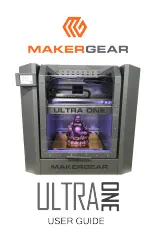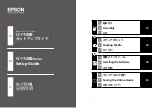
2-14
Theory of Operation
Printhead Settings
A printed card is made up of 1013 discrete vertical (short edge of the card)
columns printed across the length of the card. As each column is printed, the
printhead circuitry activates the necessary pixels to transfer pigment from the
ribbon to the card.
Controlling when and how these pixels heat up is determined by several
parameters: power, base power, and strobe.
Power
In the past, printhead pixels were controlled by varying the voltage to the pixel
element. On the newer generation of printheads, the power to the pixel is
controlled by pulsing the voltage, commonly referred to as Pulse Width
Modulation (PWM). This concept is also known as Duty-Cycle.
The heat of a thermal element on the printhead is controlled by how long it is
turned on versus how long it is turned off. In a sense, the printhead control was
analog but is now digital.
To increase the temperature, or heat, on a single element, it is turned on more
than it is turned off. The higher the duty-cycle, the hotter the element becomes.
Because the printhead now receives full voltage from the power supply,
swapping the power supply for another power supply will have an impact on
printing intensity. The printer can easily be adjusted to compensate when a new
power supply is required.
Base Power
The Base Power sets the upper limit to the power PWM. In simple terms, this sets
the bandwidth (gamut) of the printing. Increasing the base power darkens the
available colors in the printer, but does not impact the lighter colors. Note that
there is an upper threshold after which increasing the base power has little or no
effect on the final printing. At this point, the image is saturated and cannot be
increased in gamut any further. However, note that this is not the same as
darkening the image in the printer driver control panel, which will darken the
whole image, including the lighter areas.
Summary of Contents for CP80
Page 1: ...Datacard CP80 and CP80 Plus Card Printers Service Manual May 2007 Part No 539490 002 Rev C ...
Page 14: ...1 4 Introduction ...
Page 17: ...CP80 and CP80 Plus Service Manual 2 3 Print Engine Functional Block Diagram ...
Page 18: ...2 4 Theory of Operation Laminator Functional Block Diagram ...
Page 22: ...2 8 Theory of Operation LCD Service Mode Menu Diagram ...
Page 52: ...2 38 Theory of Operation ...
Page 158: ...6 6 Removal and Replacement Print Engine Front Wire Routing Diagram ...
Page 159: ...CP80 and CP80 Plus Service Manual 6 7 Print Engine Duplex and Printhead Wire Routing Diagram ...
Page 160: ...6 8 Removal and Replacement Laminator Front Wire Routing Diagram ...
Page 161: ...CP80 and CP80 Plus Service Manual 6 9 Laminator Rear Wire Routing Diagram ...
Page 162: ...6 10 Removal and Replacement Power Supply Wire Routing Diagram ...
Page 163: ...CP80 and CP80 Plus Service Manual 6 11 Print Engine Cable Connection Diagram ...
Page 164: ...6 12 Removal and Replacement Laminator Cable Connection Diagram ...
















































